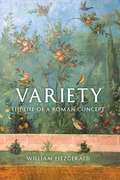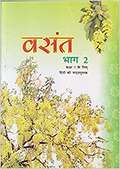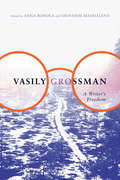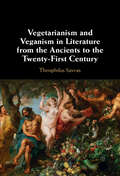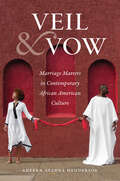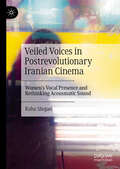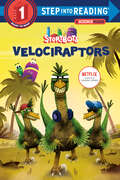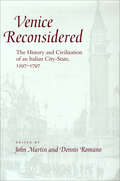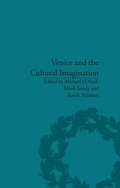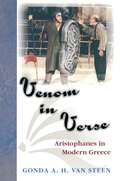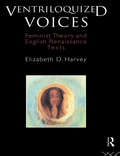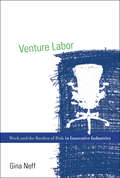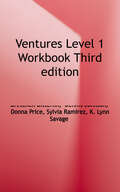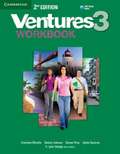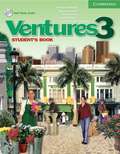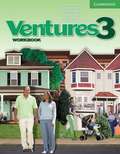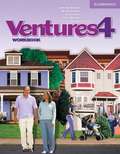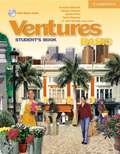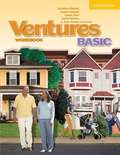- Table View
- List View
Variety: The Life of a Roman Concept
by William FitzgeraldThe idea of variety may seem too diffuse, obvious, or nebulous to be worth scrutinizing, but modern usage masks the rich history of the term. This book examines the meaning, value, and practice of variety from the vantage point of Latin literature and its reception and reveals the enduring importance of the concept up to the present day. William Fitzgerald looks at the definition and use of the Latin term varietas and how it has played out in different works and with different authors. He shows that, starting with the Romans, variety has played a key role in our thinking about nature, rhetoric, creativity, pleasure, aesthetics, and empire. From the lyric to elegy and satire, the concept of variety has helped to characterize and distinguish different genres. Arguing that the ancient Roman ideas and controversies about the value of variety have had a significant afterlife up to our own time, Fitzgerald reveals how modern understandings of diversity and choice derive from what is ultimately an ancient concept.
Vasant Bhag-1 class 6 - NCERT - 23: वसंत भाग-१ ६वीं कक्षा - एनसीईआरटी - २३
by Rashtriy Shaikshik Anusandhan Aur Prashikshan Parishadवसंत भाग-१ यह किताब राष्ट्रीय पाठ्यचर्या की रूपरेखा (2005) के आधार पर तैयार किए गए पाठ्यक्रम पर आधारित है। यह पारंपरिक भाषा शिक्षण की कई सीमाओं से आगे जाती है। राष्ट्रीय पाठ्यचर्या की नयी रूपरेखा भाषा को बच्चे के व्यक्तित्व का सबसे समृद्ध संसाधन मानते हुए उसे पाठ्यक्रम के हर विषय से जोड़कर देखती है। इस नाते पाठ्यसामग्री का चयन और अभ्यासों में बच्चे के भाषायी विकास की समग्रता को ध्यान में रखा गया है। कई अभ्यास-प्रश्न भाषा शिक्षण की परिचित परिधि से बाहर जाकर प्रकृति, समाज, विज्ञान, इतिहास आदि में बच्चे की जिज्ञासा को नए आयाम देते हैं। उदाहरण के लिए शमशेर बहादुर सिंह की कविता 'चाँद से थोड़ी सी गप्पें' में दिया गया एक प्रश्न चंद्रमा की कलाओं के बारे में है और सुभद्रा कुमारी चौहान की कविता 'झाँसी की रानी' में इतिहास और भूगोल के भी कुछ प्रश्न दिए गए हैं। ऐसे प्रश्नों के ज़रिए बच्चों को हिंदी की विपुल शब्द-संपदा के विविध हिस्सों का स्पर्श मिलेगा। वे आज के शहरी जीवन में अपेक्षाकृत कम सुनाई पड़ने वाले शब्दों और प्रयोगों को अपना सकेंगे।
Vasant Bhag-2 class 7 - NCERT - 23: वसंत भाग-२ ७वीं कक्षा - एनसीईआरटी - २३
by Rashtriy Shaikshik Anusandhan Aur Prashikshan Parishadवसंत भाग २ यह पाठ्यपुस्तक राष्ट्रीय पाठ्यचर्या की रूपरेखा (2005) के आधार पर तैयार किए गए पाठ्यक्रम पर आधारित है। यह पारंपरिक भाषा-शिक्षण की कई सीमाओं से आगे जाती है। राष्ट्रीय पाठ्यचर्या की नयी रूपरेखा भाषा को विद्यार्थी के व्यक्तित्व का सबसे समृद्ध संसाधन मानते हुए उसे पाठ्यक्रम के हर विषय से जोड़कर देखती है। इस नाते पाठ्यसामग्री का चयन और अभ्यासों में विद्यार्थी के भाषायी विकास की समग्रता को ध्यान में रखा गया है। कई प्रश्न-अभ्यास भाषा शिक्षण की परिचित परिधि से बाहर जाकर प्रकृति, समाज, विज्ञान, इतिहास आदि में विद्यार्थी की जिज्ञासा को नए आयाम देते हैं। पाठ केंद्रित प्रश्नों को क्रमशः विस्तार देते हुए पाठ के आसपास के ज्ञान-क्षेत्रों को भी दूसरे प्रश्न-समूहों में साथ रखने का प्रयास किया गया है।
Vasily Grossman: A Writer's Freedom
by Giovanni Maddalena Anna BonolaVasily Grossman (1905–1964) was a successful Soviet author and journalist, but he is more often recognized in the West as Russian literature's leading dissident. How do we account for this paradox? In the first collection of essays to explore the Russian author's life and works in English, leading experts present recent multidisciplinary research on Grossman's experiences, his place in the history of Russian literature, key themes in his writing, and the wider implications of his life and work in the realms of philosophy and politics. Born into a Jewish family in Berdychiv, Grossman was initially a supporter of the ideals of the Russian Revolution and the new Soviet state. During the Second World War, he worked as a correspondent for the Red Army newspaper and was the first journalist to write about the Nazi extermination camps. As a witness to the daily violence of the Soviet regime, Grossman became more and more aware of the nature and forms of totalitarian coercion, which gradually alienated him from the Soviet regime and earned him a reputation for dissidence. A survey of the remarkable accomplishments and legacy left by this controversial and contradictory figure, Vasily Grossman reveals a writer's power to express freedom even under totalitarianism.
Veena Bhag-1 class 3 - NCERT - 23: वीणा भाग-१ ३रीं कक्षा - एनसीईआरटी - २३
by Rashtriy Shaikshik Anusandhan Aur Prashikshan Parishad"वीणा" तीसरी कक्षा के छात्रों के लिए हिंदी पाठ्यपुस्तक है, जिसमें छात्रों के संपूर्ण विकास पर ध्यान केंद्रित किया गया है। यह पुस्तक राष्ट्रीय शिक्षा नीति 2020 और राष्ट्रीय पाठ्यचर्या की रूपरेखा 2023 के निर्देशों का पालन करती है। इसे पाँच इकाइयों में विभाजित किया गया है, जो बच्चों के पर्यावरण, मित्रता, खेल, श्रम और देशभक्ति जैसे महत्वपूर्ण विषयों को कवर करती हैं। पुस्तक में कविताएँ, कहानियाँ, निबंध, पत्र, संवाद और पहेलियाँ शामिल हैं, जो बच्चों के सोचने, समझने और प्रश्न पूछने की क्षमता को विकसित करने में सहायक हैं। पुस्तक के माध्यम से बच्चों को भारतीय पौराणिक कथा परंपरा से लेकर आधुनिक और तकनीकी रूप से विकसित भारत की छवि से परिचित कराया गया है। इसमें भाषा के सौंदर्यशास्त्रीय, सामाजिक, सांस्कृतिक, मनोवैज्ञानिक और साहित्यिक पक्षों को भी शामिल किया गया है, जिससे बच्चे केवल नियमबद्ध व्यवस्था के रूप में भाषा को न देखें, बल्कि इसके विभिन्न पहलुओं को भी समझें। इसके अलावा, पुस्तक में समावेशन, बहुभाषिकता, जेंडर समानता और सांस्कृतिक जुड़ाव को भी महत्व दिया गया है। यह पुस्तक बच्चों के सीखने की प्रक्रिया को आनंदमय और लाभप्रद बनाने के उद्देश्य से तैयार की गई है, ताकि वे सहजता से अपने मध्य स्तर में प्रवेश कर सकें और समग्र रूप से विकसित हो सकें।
Vegetarianism and Science Fiction: A History of Utopian Animal Ethics (Palgrave Studies in Animals and Literature)
by Joshua BulleidVegetarianism and Science Fiction: A History of Utopian Animal Ethics examines how vegetarian ideals promoted within science fiction and utopian literature have had a real-world impact on the awareness and spread of vegetarianism and animal advocacy, as well as how the genres' engagements have been altered to reflect changes in ethical and environmental philosophy. Author Joshua Bulleid examines the representation of vegetarianism in the works of major science fiction authors, including Mary Shelley, H. G. Wells, Arthur C. Clarke, Philip K. Dick, Ursula K. Le Guin, Ernest Callenbach, Marge Piercy, Octavia E. Butler, Kim Stanley Robinson and Margaret Atwood within their evolving social contexts, tracing the development of vegetarian trends and their science fictional representations from the early-nineteenth century to the present day.
Vegetarianism and Veganism in Literature from the Ancients to the Twenty-First Century
by Theophilus SavvasVegetarianism and Veganism in Literature from the Ancients to the Twenty-First Century re-assesses both canonical and less well-known literary texts to illuminate how vegetarianism and veganism can be understood as literary phenomena, as well as dietary and cultural practices. It offers a broad historical span ranging from ancient thinkers and writers, such as Pythagoras and Ovid, to contemporary novelists, including Ruth L. Ozeki and Jonathan Franzen. The expansive historical scope is complemented by a cross-cultural focus which emphasises that the philosophy behind these diets has developed through a dialogic relationship between east and west. The book demonstrates, also, the way in which carnivorism has functioned as an ideology, one which has underpinned actions harmful to both human and non-human animals.
Veil and Vow: Marriage Matters in Contemporary African American Culture (Gender and American Culture)
by Aneeka Ayanna HendersonIn Veil and Vow, Aneeka Ayanna Henderson places familiar, often politicized questions about the crisis of African American marriage in conversation with a rich cultural archive that includes fiction by Terry McMillan and Sister Souljah, music by Anita Baker, and films such as The Best Man. Seeking to move beyond simple assessments of marriage as "good" or "bad" for African Americans, Henderson critically examines popular and influential late twentieth- and early twenty-first-century texts alongside legislation such as the 1996 Defense of Marriage Act and the Welfare Reform Act, which masked true sources of inequality with crisis-laden myths about African American family formation. Using an interdisciplinary approach to highlight the influence of law, politics, and culture on marriage representations and practices, Henderson reveals how their kinship veils and unveils the fiction in political policy as well as the complicated political stakes of fictional and cultural texts. Providing a new opportunity to grapple with old questions, including who can be a citizen, a "wife," and "marriageable," Veil and Vow makes clear just how deeply marriage still matters in African American culture.
Veiled Voices in Postrevolutionary Iranian Cinema: Women’s Vocal Presence and Rethinking Acousmatic Sound
by Raha ShojaeiThis book examines the vocal presence of women in postrevolutionary Iranian cinema. The research explores the concept of the veiled voice, which conceals the bodily aspects of the voice and suppresses its discursive elements. Studying the "veiling" of women&’s voices in New Iranian Cinema, how they relate to authoritative voices, and their limitations in cinematic spaces, the book addresses the detachment of women&’s voices from their bodies in some films. The book argues that this detachment is often used as a feminist strategy to bypass constraints on female portrayal on camera. The book dissects how these voices are often marginalized within the cinematic space, either structurally, narratively, or due to patriarchal adherence. It also discusses the concept of the acousmatic voice, particularly in the context of Iranian cinema, where the female voice-off is used as a spatial veil, contributing to the marginalization of women. Although Michael Chion's concept of the acousmêtre is based on classic Hollywood cinema, this book shows that the mere presence of an off-screen voice does not ensure a predictable impact in the filmic world. In New Iranian Cinema, influenced by factors like modesty rules, the off-screen voice untethered to a body can serve as a presentational strategy rather than just a cinematic narrational device. The book also investigates the unveiling of the female voice as a subject of aesthetic admiration and desire within the cinematic realm, navigating censorship through religious and cinematic elements and explores how cinematic spaces manipulate the presence and embodiment of the unveiled voice to avoid revealing its true source. The book is also informed by the author's experience as the first woman sound designer working in the Iranian film industry.
Velociraptors (Step into Reading)
by Scott EmmonsThe curious crew from the Netflix series Ask the StoryBots star in an all-new Step into Reading leveled reader!Get ready to meet the rapping velociraptors. They've got pointy teeth, sharp claws, and mad rhymes. Based on a favorite StoryBots adventures, this Step 1 Science Reader will entertain boys and girls ages 4 to 6 while imparting a few fun facts about these popular carnivorous creatures.Step 1 Readers feature big type and easy words for children who know the alphabet and are eager to begin reading. Rhyme and rhythmic text is paired with picture clues to help children decode the story.
Venice Reconsidered: The History and Civilization of an Italian City-State, 1297-1797
by Dennis Romano John Jeffries MartinThis collection of essays on centuries of culture and politics is “likely to become a landmark in Venetian historiography” (The Historical Journal).Venice Reconsidered offers a dynamic portrait of Venice from the establishment of the Republic at the end of the thirteenth century to its fall to Napoleon in 1797. In contrast to earlier efforts to categorize Venice’s politics as strictly republican and its society as rigidly tripartite and hierarchical, the scholars in this volume present a more fluid and complex interpretation of Venetian culture. Drawing on a variety of disciplines—history, art history, and musicology—these essays present innovative variants of the myth of Venice—that nearly inexhaustible repertoire of stories Venetians told about themselves.
Venice and the Cultural Imagination: 'This Strange Dream upon the Water'
by Michael O’Neill Mark Sandy Sarah WoottonIn the era of the Grand Tour, Venice was the cultural jewel in the crown of Europe and the epitome of decadence. This edited collection of eleven essays draws on a range of disciplines and approaches to ask how Venice’s appeal has affected Western culture since 1800.
Venom in Verse: Aristophanes in Modern Greece (Princeton Modern Greek Studies #16)
by Gonda A.H. Van SteenAristophanes has enjoyed a conspicuous revival in nineteenth- and twentieth-century Greece. Here, Gonda Van Steen provides the first critical analysis of the role of the classical Athenian playwright in modern Greek culture, explaining how the sociopolitical "venom" of Aristophanes' verses remains relevant and appealing to modern Greek audiences. Deriding or challenging well-known figures and conservative values, Aristophanes' comedies transgress authority and continue to speak to many social groups in Greece who have found in him a witty, pointed, and accessible champion from their "native" tradition. The book addresses the broader issues reflected in the poet's revival: political and linguistic nationalism, literary and cultural authenticity versus creativity, censorship, and social strife. Van Steen's discussion ranges from attitudes toward Aristophanes before and during Greece's War of Independence in the 1820s to those during the Cold War, from feminist debates to the significance of the popular music integrated into comic revival productions, from the havoc transvestite adaptations wreaked on gender roles to the political protest symbolized by Karolos Koun's directorial choices. Crossing boundaries of classical philology, critical theory, and performance studies, the book encourages us to reassess Aristophanes' comedies as both play-acts and modern methods of communication. Van Steen uses material never before accessible in English as she proves that Aristophanes remains Greece's immortal comic genius and political voice.
Ventriloquized Voices: Feminist Theory and English Renaissance Texts
by Elizabeth D. HarveyFirst published in 1992. Routledge is an imprint of Taylor & Francis, an informa company.
Venture Labor: Work and the Burden of Risk in Innovative Industries (Acting with Technology)
by Gina NeffWhy employees of pioneering Internet companies chose to invest their time, energy, hopes, and human capital in start-up ventures.In the dot-com boom of the late 1990s, employees of Internet startups took risks—left well-paying jobs for the chance of striking it rich through stock options (only to end up unemployed a year later), relocated to areas that were epicenters of a booming industry (that shortly went bust), chose the opportunity to be creative over the stability of a set schedule. In Venture Labor, Gina Neff investigates choices like these made by high-tech workers in New York City's “Silicon Alley” in the 1990s. Why did these workers exhibit entrepreneurial behavior in their jobs—investing time, energy, and other personal resources that Neff terms “venture labor”—when they themselves were employees and not entrepreneurs?Neff argues that this behavior was part of a broader shift in society in which economic risk shifted away from collective responsibility toward individual responsibility. In the new economy, risk and reward took the place of job loyalty, and the dot-com boom helped glorify risks. Company flexibility was gained at the expense of employee security. Through extensive interviews, Neff finds not the triumph of the entrepreneurial spirit but a mixture of motivations and strategies, informed variously by bravado, naïveté, and cold calculation. She connects these individual choices with larger social and economic structures, making it clear that understanding venture labor is of paramount importance for encouraging innovation and, even more important, for creating sustainable work environments that support workers.
Ventures Workbook: Level 1 (Ventures Series)
by Gretchen Bitterlin Dennis Johnson Donna Price Sylvia RamirezThe Ventures 3rd Edition Level 1 Workbook has exercises to help reinforce lessons in the Student's Book, with an answer key for self-study. Students can access audio to help improve listening, grammar, and reading comprehension using QR codes found throughout the Workbook.
Ventures 3 Workbook (2nd Edition)
by Gretchen Bitterlin Dennis Johnson Donna Price Sylvia Ramirez K. Lynn Savage Ingrid WisniewskaVentures 2nd Edition is a six-level, standards-based ESL series for adult-education ESL. The Ventures 2nd Edition Level 3 Workbook provides reinforcement exercises for each lesson in the Student's Book, an answer key for self-study, grammar charts, and examples of a variety of forms and documents.
Ventures 3: Student's Book
by Gretchen Bitterlin Dennis Johnson Donna Price Sylvia Ramirez K. Lynn SavageVentures is a five-level, standards-based ESL series for Adult Education ESL. Each Student's Book contains 10 topical units composed of six lessons each. The two-page lessons are designed for an hour of classroom instruction. Culture notes and speaking, reading, and writing tips enrich and support exercises. Review units include sections focusing on pronunciation.
Ventures 3: Workbook
by Gretchen Bitterlin Dennis Johnson Donna Price Sylvia Ramirez K. Lynn SavageVentures is a five-level, standards-based ESL series for Adult Education ESL. The Workbook provides reinforcement exercises for each lesson in the Student's Book, an answer key for self-study, grammar charts, and examples of a variety of forms and documents.
Ventures 4: Workbook
by Gretchen Bitterlin Dennis Johnson Donna Price Sylvia Ramirez K. Lynn Savage Kristin L. JohannsenThe Workbook provides reinforcement exercises for each lesson in the Student's Book, an answer key for self-study, and grammar charts.
Ventures Basic Student's Book (Ventures)
by Gretchen BitterlinVentures 2nd Edition is a six-level, standards-based ESL series for adult-education ESL. Ventures 2nd Edition Basic Student's Book contains 10 units composed of six lessons each on relevant adult-learner themes. The two-page lessons are designed for an hour of classroom instruction. Culture notes and speaking, reading, and writing tips enrich and support exercises. Review units include sections focusing on pronunciation.
Ventures Basic: Student's Book
by Gretchen Bitterlin Dennis Johnson Donna Price Sylvia Ramirez K. Lynn SavageVentures is a five-level, standards-based ESL series for Adult Education ESL. Each Student's Book contains 10 topical units composed of six lessons each. The two-page lessons are designed for an hour of classroom instruction. Culture notes and speaking, reading, and writing tips enrich and support exercises. Review units include sections focusing on pronunciation.
Ventures Basic: Workbook
by Gretchen Bitterlin Dennis Johnson Donna Price Sylvia Ramirez K. Lynn SavageThe Workbook provides reinforcement exercises for each lesson in the Student's Book, an answer key for self-study, grammar charts, and examples of a variety of forms and documents.
Ventures Level 1 Student's Book (Ventures)
by Gretchen Bitterlin Dennis Johnson Donna Price Sylvia Ramirez K. Lynn SavageThis Student's Book has 10 units with six lessons each, based on relevant adult-learner themes. Two-page lessons are designed for an hour of classroom instruction and are aligned to teach students the skills needed for success in college and careers. Culture notes, speaking, reading, and writing tips enrich and support exercises. Review Units include sections focusing on pronunciation. A College and Careers section in the back of the book addresses needs for more reading practice. Students can access audio and grammar presentation videos using the QR codes found throughout the book.
Ventures Level 1 Teacher's Edition (Ventures Ser.)
by Gretchen Bitterlin Dennis Johnson Donna Price Sylvia Ramirez K. Lynn SavageThe Ventures 3rd Edition Level 1 Teacher's Edition has easy-to-follow lesson plans with tips and suggestions throughout, addressing common areas of difficulty for students and suggested expansion activities for improving learner persistence. The Teacher's Edition also explains where to find additional practice in other components such as the Workbook, Online Teacher's Resources, tests, and the Ventures Arcade.
